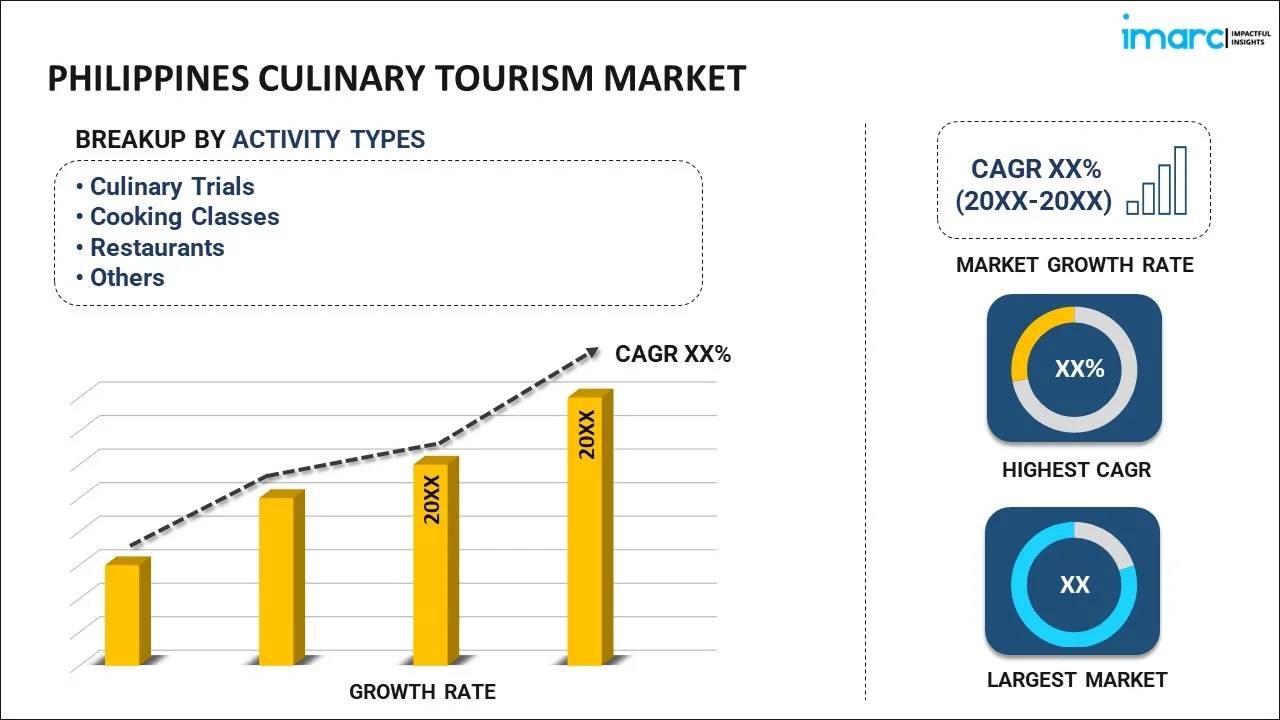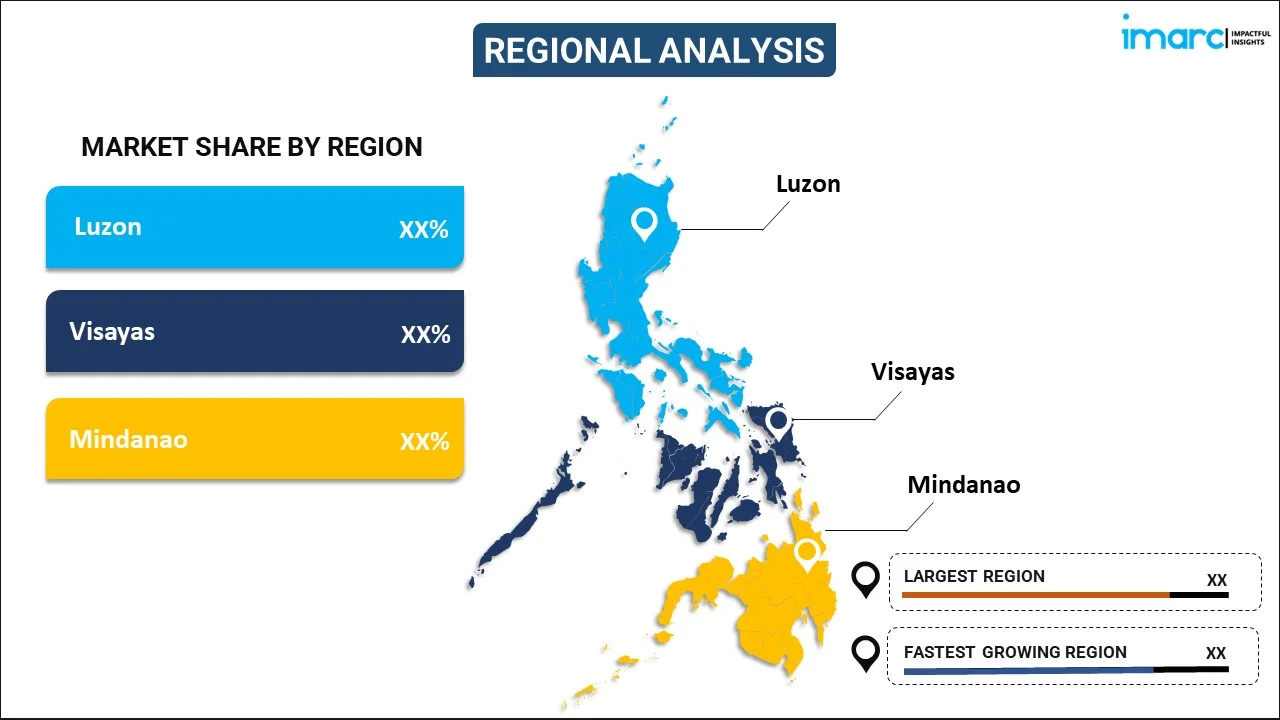
Philippines Culinary Tourism Market Report by Activity Type (Culinary Trials, Cooking Classes, Restaurants, Food Festivals and Events, and Others), Tour Type (Domestic, International), Age Group (Baby Boomers, Generation X, Generation Y, Generation Z), Mode of Booking (Online Travel Agents, Traditional Agents, Direct Booking), and Region 2025-2033
Philippines Culinary Tourism Market Overview:
The Philippines culinary tourism market size is projected to exhibit a growth rate (CAGR) of 11.3% during 2025-2033. The market is growing mainly driven by an emphasis on authentic local cuisine, growth in gastronomic tours and culinary schools, and the popularity of food festivals. Strategic promotions and social media influence further enhance the appeal, making the country a top destination for food enthusiasts, thereby contributing to the market growth.
|
Report Attribute
|
Key Statistics
|
|---|---|
|
Base Year
|
2024 |
|
Forecast Years
|
2025-2033
|
|
Historical Years
|
2019-2024
|
| Market Growth Rate (2025-2033) | 11.3% |
Philippines Culinary Tourism Market Trends:
Rising Emphasis on Authentic Local Cuisine
The demand for authentic local experiences in Philippines has significantly boosted culinary tourism with travelers seeking to explore traditional Filipino dishes. Culinary tours now frequently feature local food markets, street food vendors and rural dining experiences where visitors can savor iconic dishes like adobo, sinigang and lechon. These tours often include interactive elements like cooking classes and farm visits which offers a deeper understanding of Filipino culinary traditions. Government and private sector initiatives plays an important role in this trend promoting regional culinary heritage through various programs and festivals. According to an article published by the Philippines News Agency, in January 2024, there is a need to enhance the Philippines’ tourism services and promote its native cuisine and its sports industry to boost global competitiveness. The Private Sector Advisory Council’s (PSAC) Tourism Sector proposed strategies to attract more tourists including simplifying visa applications and improving airport connectivity. The council also recommended promoting food festivals and hosting major sporting events to increase tourist arrivals. Tourist arrivals in the Philippines reached over 5.4 million last year, with tourism receipts totaling PHP482.54 billion. These efforts not only preserve local food culture but also attract international tourists looking for genuine and immersive culinary adventures. The focus on authenticity and regional diversity enhances the overall tourism experience making the Philippines a compelling destination for food enthusiasts.
Growth of Gastronomic Tours and Culinary Schools
The rise in gastronomic tours and culinary schools in Philippines has significantly enhanced culinary tourism. Increasingly tourists nowadays are drawn to short term courses and tools that provide immersive culinary experiences. These tools typically include visits to local farm, fishing villages and traditional kitchens where participants can engage in hands on cooking sessions. According to an article published by TTG Asia in May 2024, the Philippine Department of Tourism promotes the integration of food and gastronomy within cultural experiences to boost tourism and support local economies. Secretary Christina Garcia Frasco highlights the economic and cultural benefits of gastronomy tourism in the Asia-Pacific region. The Philippines will host the First UN Tourism Regional Forum on Gastronomy Tourism for Asia and the Pacific from June 26 to 27 in Cebu, aiming to develop the region's food tourism further. Culinary schools also offer workshops and classes that cater to different skill levels, from beginners to advanced cooks, providing a comprehensive learning experience. These initiatives not only educate tourists about Filipino food but also promote sustainable tourism by supporting local communities and preserving culinary heritage.
Philippines Culinary Tourism Market News:
- In April 2024, the Department of Tourism (DOT) has launched the "Philippines Eatsperience," a yearlong food tourism program to showcase local cuisine and popular Filipino street food in Manila. The program, part of DOT's Philippine Experience Program (PEP), aims to highlight the best of Filipino cuisine, with the initial launch in Rizal Park and Intramuros. The initiative seeks to partner with local government units and businesses, with more than 30 food and beverage establishments participating in the program.
- In September 2023, Rajah Travel launched Freestyle Cruising with Norwegian Cruising Line. The cruising experience aims to offer a wide range of dining options and onboard entertainment to its customers.
Philippines Culinary Tourism Market Segmentation:
IMARC Group provides an analysis of the key trends in each segment of the market, along with forecasts at the country level for 2025-2033. Our report has categorized the market based on activity type, tour type, age group, and mode of booking.
Activity Type Insights:

- Culinary Trials
- Cooking Classes
- Restaurants
- Food Festivals and Events
- Others
The report has provided a detailed breakup and analysis of the market based on the activity type. This includes culinary trials, cooking classes, restaurants, food festivals and events, and others.
Tour Type Insights:
- Domestic
- International
A detailed breakup and analysis of the market based on the tour type have also been provided in the report. This includes domestic and international.
Age Group Insights:
- Baby Boomers
- Generation X
- Generation Y
- Generation Z
The report has provided a detailed breakup and analysis of the market based on the age group. This includes baby boomers, generation X, generation Y, and generation Z.
Mode of Booking Insights:
- Online Travel Agents
- Traditional Agents
- Direct Booking
A detailed breakup and analysis of the market based on the mode of booking have also been provided in the report. This includes online travel agents, traditional agents, and direct booking.
Regional Insights:

- Luzon
- Visayas
- Mindanao
The report has also provided a comprehensive analysis of all the major regional markets, which include Luzon, Visayas, and Mindanao.
Competitive Landscape:
The market research report has also provided a comprehensive analysis of the competitive landscape. Competitive analysis such as market structure, key player positioning, top winning strategies, competitive dashboard, and company evaluation quadrant has been covered in the report. Also, detailed profiles of all major companies have been provided.
Philippines Culinary Tourism Market Report Coverage:
| Report Features | Details |
|---|---|
| Base Year of the Analysis | 2024 |
| Historical Period | 2019-2024 |
| Forecast Period | 2025-2033 |
| Units | Million USD |
| Scope of the Report | Exploration of Historical and Forecast Trends, Industry Catalysts and Challenges, Segment-Wise Historical and Predictive Market Assessment:
|
| Activity Types Covered | Culinary Trials, Cooking Classes, Restaurants, Food Festivals and Events, Others |
| Tour Types Covered | Domestic, International |
| Age Groups Covered | Baby Boomers, Generation X, Generation Y, Generation Z |
| Mode of Bookings Covered | Online Travel Agents, Traditional Agents, Direct Booking |
| Regions Covered | Luzon, Visayas, Mindanao |
| Customization Scope | 10% Free Customization |
| Post-Sale Analyst Support | 10-12 Weeks |
| Delivery Format | PDF and Excel through Email (We can also provide the editable version of the report in PPT/Word format on special request) |
Key Questions Answered in This Report:
- How has the Philippines culinary tourism market performed so far and how will it perform in the coming years?
- What has been the impact of COVID-19 on the Philippines culinary tourism market?
- What is the breakup of the Philippines culinary tourism market on the basis of activity type?
- What is the breakup of the Philippines culinary tourism market on the basis of tour type?
- What is the breakup of the Philippines culinary tourism market on the basis of age group?
- What is the breakup of the Philippines culinary tourism market on the basis of mode of booking?
- What are the various stages in the value chain of the Philippines culinary tourism market?
- What are the key driving factors and challenges in the Philippines culinary tourism?
- What is the structure of the Philippines culinary tourism market and who are the key players?
- What is the degree of competition in the Philippines culinary tourism market?
Key Benefits for Stakeholders:
- IMARC’s industry report offers a comprehensive quantitative analysis of various market segments, historical and current market trends, market forecasts, and dynamics of the Philippines culinary tourism market from 2019-2033.
- The research report provides the latest information on the market drivers, challenges, and opportunities in the Philippines culinary tourism market.
- Porter's five forces analysis assist stakeholders in assessing the impact of new entrants, competitive rivalry, supplier power, buyer power, and the threat of substitution. It helps stakeholders to analyze the level of competition within the Philippines culinary tourism industry and its attractiveness.
- Competitive landscape allows stakeholders to understand their competitive environment and provides an insight into the current positions of key players in the market.
Need more help?
- Speak to our experienced analysts for insights on the current market scenarios.
- Include additional segments and countries to customize the report as per your requirement.
- Gain an unparalleled competitive advantage in your domain by understanding how to utilize the report and positively impacting your operations and revenue.
- For further assistance, please connect with our analysts.
 Inquire Before Buying
Inquire Before Buying
 Speak to an Analyst
Speak to an Analyst
 Request Brochure
Request Brochure
 Request Customization
Request Customization




.webp)




.webp)












